Chthonocephalus is a genus of annual herbs in the family Asteraceae. The genus is endemic to Australia, with species occurring in all mainland states.
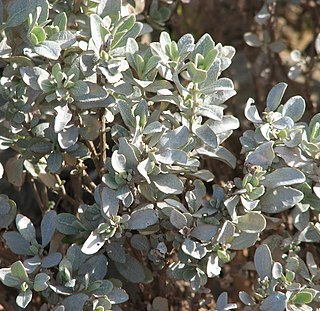
Atriplex vesicaria, commonly known as bladder saltbush, is a species of saltbush endemic to Australia.
Hyalosperma is a genus of Australian flowering plants in the family Asteraceae.

Banksia sessilis var. cordata is a variety of Banksia sessilis, with unusually large leaves and flower heads. It is a rare variety that is restricted to the extreme south-west corner of Western Australia.
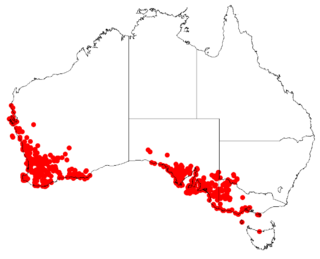
Podotheca angustifolia, commonly known as sticky longheads, is a species of herb native to Australia.
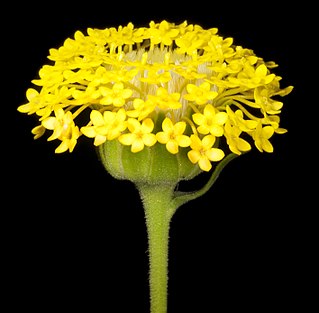
Podotheca is a genus of flowering plants in the tribe Gnaphalieae within the family Asteraceae. All species are endemic to Western Australia, except for Podotheca angustifolia which occurs across the south of Australia.

Xanthostemon chrysanthus, the golden penda or first love, is a species of tree in the myrtle family Myrtaceae, endemic to north eastern Queensland, Australia. It is a popular garden plant with showy yellow blooms.
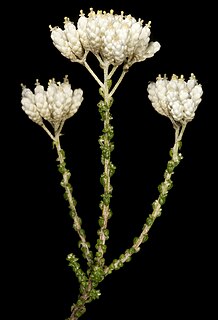
Ozothamnus lepidophyllus is a shrub in the family Asteraceae, native to Western Australia. It is erect, growing from 0.25 to 0.6 m high with white flowers and grows on loamy, sandy and rocky soils.

Waitzia acuminata, commonly known as orange immortelle, is an annual herb in the family Asteraceae. It is native to Australia. Plants grow to between 0.1 and 0.6 metres in height and have leaves that are long and narrow. These are between 2 and 10 cm long and 2 to 5 mm in width. The yellow, orange or white flowers appear between July and January.
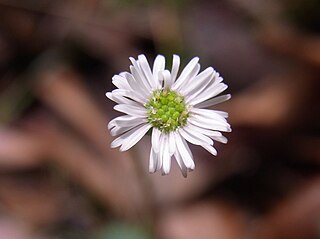
Lagenophora gracilis is a small plant in the daisy family, found in eastern Australia, and in tropical Asia. Common names include Slender Bottle-daisy and Slender Lagenophora. The habitat is the floor of Eucalyptus forests, often in moist situations.

Opercularia echinocephala is a species of plant within the genus Opercularia, in the family Rubiaceae. It is endemic to the southwest of Western Australia.
Olearia revoluta is a plant species in the sunflower family, Asteraceae, that is endemic to Western Australia.
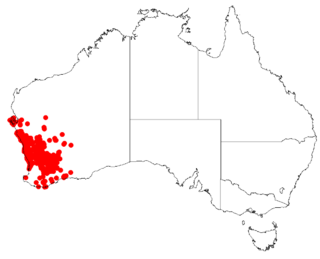
Podotheca gnaphalioides is a small annual herb in the family Asteraceae, endemic to Western Australia. It grows from 2 cm to 60 cm tall and is an often sticky herb, which is erect or decumbent, and whose yellow or orange-yellow flowers are seen from August to November. It grows on a variety of soils, but tends to prefer sandy soils.

Tetratheca hispidissima is an erect spreading or straggling shrub in the family Elaeocarpaceae. It is endemic to Western Australia. It grows from 0.3 m to 0.8 m high, on sandy, clayey and gravel soils on river flats and on lateritic ridges. Its pink to purple flowers may be seen from September to December.
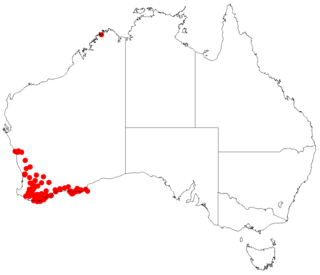
Asteridea nivea is a herb in the Asteraceae family, which is endemic to Western Australia. It was first described in 1845 by Joachim Steetz as Chrysodiscus niveus. In 1980, G. Kroner assigned it to the genus, Asteridea, giving it the name Asteridea nivea. It is a perennial herb, sometimes erect, sometimes low-spreading which grows on sandy soils often over granite, laterite, or limestone to heights from 10 cm to 60 cm, in rock crevices, on ridges and coastal cliffs. Its white to white-pink flowers may seen from April to May or August to September in Beard's South-West Province, that is, the IBRA regions of Avon Wheatbelt, Esperance Plains, Geraldton Sandplains, Jarrah Forest, Mallee, and Warren.

Argentipallium niveum is a species of flowering plant within the genus, Argentipallium, in the daisy family (Asteraceae). It is endemic to Western Australia.
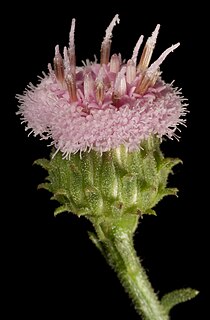
Pluchea dentex is a plant in the Asteraceae family, first described in 1867 by George Bentham, from specimens collected in Queensland by Robert Brown at Broad Sound and Thirsty Sound, by Ferdinand von Mueller at the source of the Gilbert River, and one by Eugene Fitzalan at Port Denison.

Pogonolepis stricta is a species of flowering plant in the family Asteraceae, which is endemic to Western Australia. It was first described by Joachim Steetz in 1845.

Pterochaeta is a monotypic plant genus in the Asteraceae family, endemic to Western Australia. It was first described in 1845 by Joachim Steetz and its only species is Pterochaeta paniculata.

Olearia paucidentata is a plant in the Asteraceae family. It was first described as Eurybia paucidentata in 1845 by Joachim Steetz. In 1867, George Bentham assigned it to the genus Olearia in his Flora Australiensis.



















